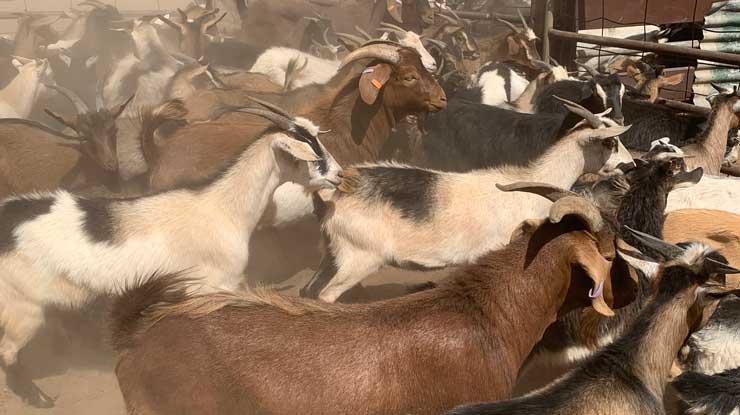Supply growth: a wrap of 2021–22 and outlook for 2022–23
29 November 2022
 Caption: Rangeland goats at Bourke, NSW. Credit: G. Turnbull
Caption: Rangeland goats at Bourke, NSW. Credit: G. Turnbull
Key points:
The Australian goatmeat industry had a booming year in 2021–22, processing 1.56 million goats nationally.
- NSW remains the most significant production state, supplying 64% of the goats slaughtered in 2021–22.
- Increased processing carried through to a 28% increase in exports to 20,075 tonnes, and an 81% increase in value to $300 million.
- The Goatmeat Forecasting Committee is predicting another bumper production year, expecting supply to increase significantly again in 2022–23.
At the start of 2021–22, it was clear that improved supply would increase processing numbers, but the question remained by how much? The Goatmeat Forecasting Committee projected that supply would reach at least 1.44 million goats, a 35% increase from 2020–21.
The industry had a booming year, processing 1.56 million goats nationally. The industry’s forecast had an 8% error, a reasonable result given the uncertainty regarding supply recovery last year.
While the 46% growth in processing was substantial, processing totals remain lower than historical levels. The number of goats processed in Australia peaked at 2.62 million in 2013–14.
Herd building in New South Wales and Queensland enabled the supply lift as the progeny of retained does began flowing onto the market at the start of the financial year. Favourable seasonal conditions across all regions further aided supply by bolstering reproduction and growth rates, lifting production in managed and unmanaged systems.
Early in 2022, NSW depot operators reported producers selling cull does to rationalise breeder numbers as the next generation of females matured. This turn-off further added to supply and potentially signalled a slowdown of the herd building in NSW.
Rebound in processing
The rebound in processing occurred in all states, with slaughter totals increasing substantially in Victoria (41%), Queensland (49%), South Australia (66%), NSW (28%) and Western Australia (73%) compared with the previous year.
NSW remains the most significant production state, supplying 64% of the goats slaughtered in 2021– 22 and providing a substantial proportion of goats killed in Victoria (97%), South Australia (36%) and Queensland (20%).
The number of NSW goats supplied to processing increased by 31% between 2020–21 and 202–22. Increases in supply from Queensland (64%), South Australia (52%) and Western Australia (48%) also drove up the number of goats available for processing.
Price movements
Prices remained buoyant during 2021–22, with the eastern states over the hooks (OTH) price averaging 886 c/kg carcase weight (cwt), although, the price dropped in October 2022 to 680 c/kg cwt, presumably in response to the increased supply.
The increased processing carried through to a 28% increase in exports to 20,075 tonnes, and an 81% increase in value to $300 million. There was a substantial increase in the volume and value of exports sent to major markets, including the US, South Korea, Canada and Trinidad & Tobago.
The Forecasting Committee is predicting another bumper production year, expecting supply to increase significantly again in 2022–23. However, supply has been disrupted by wet conditions and road closures in October and November 2022.
The Committee will watch the quarterly results for 2022–23 and how well processors and markets absorb the expanding supply when turn-off conditions improve.
The NSW Department of Primary Industries (NSW DPI) and Meat & Livestock Australia (MLA) co-fund the Goat Industry Data Collation and Tracking Project that collates this information on supply and processing trends for the industry. The project has considerably improved the industry's access to reliable data and its capacity to forecast population and supply changes.


